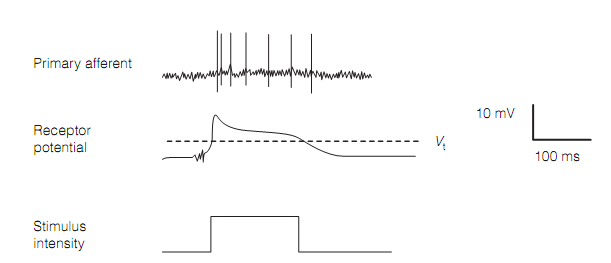Receptor potentials
The Sensory receptors create a receptor potential, a modification in their membrane potential, in response to suitable stimulation. This process is termed as transduction and is dissimilar in various receptors. For somatosensory systems, the sensory receptor is the altered ending of the main afferent neuron, and is depolarized directly by the stimulus. In other sensory systems the sensory receptor is an expert cell type that forms the synaptic connections with the first afferent neuron. Here, the alteration in membrane potential alters sensory cell neurotransmitter release, with effects on the main afferent. In vertebrates, all the sensory receptors, except photoreceptors, depolarize whenever stimulated. The Photoreceptors are hyperpolarized by the light.
The Receptor potentials allocate most of the properties of synaptic potentials which is shown in figure below. They are little amplitude, graded in size depending on the stimulus strength, passively conducted in excess of the receptor cell surface or along the neurites, decay with time and distance and can be summated. The receptor potential will trigger the action potentials for as long as it remains beyond the firing threshold, the frequency of firing will be higher, and the greater is its amplitude. The Sensory receptors elaborate adaptation, a decline in response over time to a steady stimulus.

Figure: The Receptor potential and discharge of a slowly adapting cutaneous mechanoreceptor afferent in response to the 150 ms indention of skin. Here,V=threshold voltage.
The Receptors are categorized as mechanoreceptors, found in muscles, skin, joints, and viscera; thermoreceptors, restricted to the skin; and nociceptors thatare found almost everywhere except the brain.